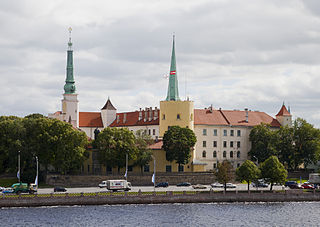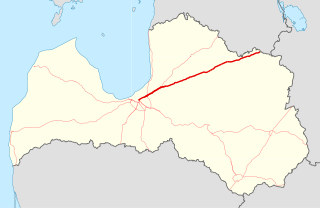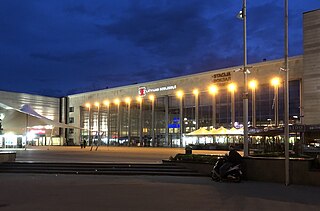
Latvia, officially the Republic of Latvia, is a country in the Baltic region of Northern Europe. It is one of the three Baltic states, along with Estonia to the north and Lithuania to the south. It borders Russia to the east and Belarus to the southeast, and shares a maritime border with Sweden to the west. Latvia covers an area of 64,589 km2 (24,938 sq mi), with a population of 1.9 million. The country has a temperate seasonal climate. Its capital and largest city is Riga. Latvians belong to the ethnolinguistic group of the Balts and speak Latvian. Russians are the most prominent minority in the country, at almost a quarter of the population; 37.7% of the population speak Russian as their native tongue.

Riga is the capital, the primate, and the largest city of Latvia. Home to 605,273 inhabitants, the city accounts for a third of Latvia's total population. The population of Riga metropolitan area, which stretches beyond the city limits, is estimated at 860,142. The city lies on the Gulf of Riga at the mouth of the Daugava river where it meets the Baltic Sea. Riga's territory covers 307.17 km2 (118.60 sq mi) and lies 1–10 m (3–33 ft) above sea level on a flat and sandy plain.
Latvian mythology is the collection of myths that have emerged throughout the history of Latvia, sometimes being elaborated upon by successive generations, and at other times being rejected and replaced by other explanatory narratives. These myths, for the most part, likely stem from Proto-Indo-European practices and the later folk traditions of the Latvian people and pre-Christian Baltic mythology.

airBaltic, legally incorporated as AS Air Baltic Corporation, is the flag carrier of Latvia, with its head office on the grounds of Riga International Airport in Mārupe municipality near Riga. Its main hub is Riga, and it operates bases in Tallinn, Vilnius, Tampere and a seasonal base in Las Palmas launched in 2023. It is 97% owned by the Government of Latvia. It operates flights solely on Airbus A220 planes. It operates a frequent-flyer program and a buy on board menu offering food and drinks for purchase.

Jūrmala is a state city in Latvia, about 25 kilometres west of Riga. Jūrmala is a resort town stretching 32 km and is sandwiched between the Gulf of Riga and the Lielupe River. It has a 33 km stretch of white-sand beach and is the fifth-largest city in Latvia.

The Latvia national football team represents Latvia in men's international football, and is controlled by the Latvian Football Federation, the governing body for football in Latvia. They have never qualified for the FIFA World Cup, but did qualify for the European Championship in 2004 under head coach Aleksandrs Starkovs.

RIX Riga Airport is the international airport of Riga, the capital of Latvia, and the largest airport in the Baltic states with direct flights to 107 destinations as of September 2024. It serves as a hub for airBaltic, SmartLynx Airlines and RAF-Avia, and as one of the base airports for Ryanair. The Latvian national carrier airBaltic is the largest carrier that serves the airport, followed by Ryanair. The airport is located in the Mārupe Municipality west of Riga, approximately 10 km from its city centre.

Riga Castle is a castle on the banks of River Daugava in Riga, the capital of Latvia. The castle was founded in 1330. Its structure was thoroughly rebuilt between 1497 and 1515. Upon the castle's seizure by the Swedes, they constructed spacious annexes in 1641. The fortress was continually augmented and reconstructed between the 17th and 19th centuries. Sometime in the 1930s, some renovation work was done by architect Eižens Laube. The Latvian government declared the castle its residence in 1938. Today it is the official residence of the President of Latvia as well as home to several museums.

Daugava National Stadium is a multifunctional stadium in Riga, Latvia, which was first opened in 1927. It holds football and athletics competitions. Since 1992 the Daugava Stadium has been designated as a sports facility of national importance. It is owned by the Government of Latvia.

The Freedom Monument is a monument located in Riga, Latvia, honouring soldiers killed during the Latvian War of Independence (1918–1920). It is considered an important symbol of the freedom, independence, and sovereignty of Latvia. Unveiled in 1935, the 42-metre (138 ft) high monument of granite, travertine, and copper often serves as the focal point of public gatherings and official ceremonies in Riga.
Rīgas Satiksme is a municipally-owned public transportation and infrastructure company serving Riga, Latvia and the surrounding areas. It was founded on 20 February 2003 as an umbrella organisation for the respective operators of trams, buses and trolleybuses in the city of Riga. Two years later, the separate operators of the different modes of public transport were merged and re-branded to its current name.

Pasažieru vilciens is the only passenger-carrying railway company in Latvia, operating both electric and diesel trains on various lines throughout the country. It was formed in November 2001 by bringing together two separate companies, PPU Elektrovilciens and PPU Dīzeļvilciens under one name, creating the first subsidiary of Latvian Railways. As of October 2008 JSC "Pasažieru vilciens" is an independent state-owned company. As of 2017, the company employed 1,075 people.

Laima is the largest producer of confectionery in Latvia. Its named after Laima, the goddess of fate in Latvian mythology and headquartered in Riga.

JSC Latvian Railway was established on 2 September 1991. It is seen as the successor of the Latvian State Railways company which was established on 5 August 1919 and dissolved by the Soviet occupation of Latvia in 1940.

The A2 highway, also known as the Vidzeme or Pskov highway is a national road in Latvia, which connects Riga to the Estonian border (Veclaicene). The highway continues in Estonia as highway 7, and then in Russia as A212 until Pskov. The highway is fully covered in asphalt and its length in Latvia is 196 km. Currently the A2 has 2x2 lanes from Riga until almost Sigulda, after that it turns to 1x1 lanes. From Riga bypass the highway is a part of European route E77.

Riga Central Station is the main railway station in Riga, Latvia. It is known as the main point of Riga due to its central location, and most forms of public transport stop in this area. Part of the building is a shopping centre.

Nils Ušakovs is a Latvian politician, former mayor of Riga and former journalist. He was the board chairman of the left-wing party alliance Harmony Centre (2005–2014) and afterwards board chairman of the Social Democratic Party "Harmony" (2014–2019). In 2009 Ušakovs was elected the Mayor of Riga, becoming the first ethnic Russian Riga Mayor since Latvia's restoration of sovereignty in 1991, a position he continuously held until his dismissal in 2019.

Andris Bērziņš is a Latvian businessman and politician who was President of Latvia from 2011 to 2015. Bērziņš was the President of Unibanka from 1993 to 2004. He was elected as President by the Saeima on 2 June 2011.
Valdis Celms is a Latvian artist, graphic designer and neopagan leader. He is known for his kinetic art and is one of the leaders of the Baltic neopagan organization Latvijas Dievtuŗu sadraudze.
Kristaps Gulbis is a Latvian sculptor and artist known for numerous contemporary art projects in more than 25 countries. His works have been exhibited at the Venice Biennale, the Museum of Modern Art in Hokaido, Japan, and at metropolitan sites in London, Paris, Rome, Berlin, Riga, Moscow and other European cities, as well as in New York, Seoul, and Kaohsiung, Taiwan. The visual art projects curated, directed and managed by Gulbis have been set in England, Hungary, Germany, Latvia, Estonia and elsewhere in Europe.

















